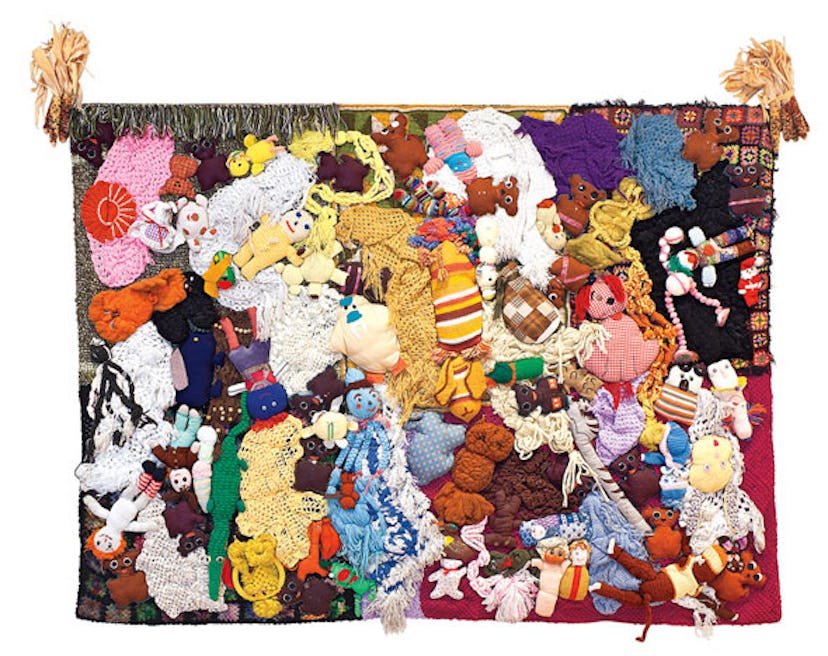Craft Work
Mike Kelley propelled the detritus of daily life into the highest echelons of the art world. Michael Slenske honors the late punk prankster.

“I’ve always said that good art is what I remember, and I certainly remember a lot of Mike’s work,” says John Baldessari of his former student Mike Kelley, whose suicide in January rocked the art world. One of the most influential artists of his generation, Kelley rebelled against his conceptualist forebears with a dizzying stream of complex works that challenged art world values. He made the ugly pretty, the worthless priceless, and the tragic redemptive; he also helped cement Los Angeles’s reputation as an international art hub, especially thanks to his installations that included large-scale drawings and paintings, as well as sculptures, videos, and his own writing. That eclectic oeuvre will be showcased in “Mike Kelley,” the four-years-in-the-making retrospective opening December 15 at Amsterdam’s Stedelijk Museum. (The show runs through April 1, 2013, then travels to Paris’s Centre Pompidou, New York’s MoMA PS1, and the Museum of Contemporary Art in Los Angeles.)
Kelley in 1989.
For more than three decades, the self-described “blue-collar anarchist” conjured the kind of punk magic that propelled thrift store afghan rugs, stuffed animals, and other banal objects into the highest climes of the art world. “I loved his work from the very beginning,” says the film director John Waters, a longtime collector of Kelley’s pieces, noting that the artist’s deft application of black humor started what Waters jokingly calls “the Pitiful Movement.” He points to Kelley’s 2010 “Arenas” show at New York’s Skarstedt Gallery, which featured seven sculptures consisting of stuffed animals placed on blankets. “Just by taking these pitiful dirty things and putting them in a gallery, he could make somebody see something in a different way. And I love that they’ve grown in value more than gold!” Waters says, referring to the fact that Kelley originally was using these discarded crafts to comment on the commodification of the art market.
Born in a Detroit suburb to a maintenance worker and a Ford Motor Company cook, Kelley suffered all his life from agoraphobia, yet he made his first works on the stage. While an undergrad at the University of Michigan in 1973, he played drums with the influential noise-rock group Destroy All Monsters, which he cofounded with the artist-musician Jim Shaw, among others. At the California Institute of the Arts in the seventies, where his teachers included Baldessari and Laurie Anderson, Kelley became an incandescent performance artist who “drove himself into these frenzied states,” recalls the video artist Tony Oursler, Kelley’s then roommate. “He would babble faster than anyone could think.” Riffing off absurdist scripts, he could charge a room with the simplest of props: “transforming himself,” recalls Oursler, “with only a bucket full of water with a whoopee cushion inside it or a cardboard tube stuffed with tin foil and a microphone.”
From top: Kandor 18 B, 2010; Horse Busts, Horse Bodies (detail), 2005.
Fellow Los Angeles artist Paul McCarthy, who became equally transfixed by Kelley’s stage presence during a performance festival in the early eighties, soon struck up a collaboration with him on a series of psychobiographic videos. Their first was Family Tyranny (1987), about an abusive father-son relationship. “We knew we had similar interests in family, architecture, low-culture objects, and this thing of costumes and pretend,” says McCarthy, who along with Kelley was a breakout star of MOCA’s seminal 1992 survey “Helter Skelter: L.A. Art in the 1990s.”
McCarthy remembers how his hours-long conversations with Kelley would often lead to unlikely projects. “It was a lot of laughing, making jokes, and then all of a sudden we’d see something and go, ‘That’s an idea. We should do it.’ Then it’s like, ‘Should we really do it?’ And then we’re remaking Vito Acconci performances [with models portraying porn stars] in a house in Beverly Hills like it’s a commune, like a joke.”
Kelley was in the midst of a new project when he killed himself at age 57, leaving no note. Former bandmate Jim Shaw recalls that the week of his death, Kelley sent over assistants to Shaw’s studio to borrow mannequins for pieces he was making involving recorded versions of his diaries. The pair had last collaborated on the 2011 Destroy All Monsters book and show at Los Angeles’s Prism gallery. “He was fully engaged—more fully than he ever needed to be,” says Shaw, who is still perplexed by the loss and the work Kelley left unfinished. So, too, is Baldessari: “He didn’t rely on past successes; he was always evolving and reaching for something,” he says. “We don’t even know if he was at the pinnacle of his career.”
Clockwise, from top: photograph by Douglas M. Parker/courtesy Of The Michael D. Kelley Estate Foundation/Kelley Studio Inc.; Copyright 1989 Los Angeles Times, Used With Permission; Kelley Studio Inc./Mike Kelley Foundation For The Arts, Courtesy Of The Foundation And Gagosian Gallery/Photographs By Fredrik Nilsen (2)